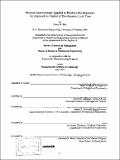| dc.contributor.advisor | Steven D. Eppinger and Daniel E. Whitney. | en_US |
| dc.contributor.author | Mar, Carey W. (Carey William), 1970- | en_US |
| dc.date.accessioned | 2005-08-19T20:06:47Z | |
| dc.date.available | 2005-08-19T20:06:47Z | |
| dc.date.copyright | 1999 | en_US |
| dc.date.issued | 1999 | en_US |
| dc.identifier.uri | http://hdl.handle.net/1721.1/9778 | |
| dc.description | Thesis (S.M.)--Massachusetts Institute of Technology, Sloan School of Management; and, (S.M.)--Massachusetts Institute of Technology, Dept. of Mechanical Engineering, 1999. | en_US |
| dc.description | Includes bibliographical references (p. 113-114). | en_US |
| dc.description.abstract | Speed and flexibility in product development will be the differentiators that determine which companies will have competitive advantages in the next decade. To this end, many authors have advanced frameworks and tools for streamlining product development processes, all with the objective of reducing the time required to engineer and deliver a quality product. Frameworks such as concurrent engineering describe what the process should evolve to, while tools such as cross-functional teams address implementation. But one element that has not been clearly addressed is the measurement and improvement of the development process during the pursuit of this goal. The focus of this thesis is on the design of an approach to improve the product development process, based on applying established process improvement techniques and project simulation. The objective of the improvement effort is to increase control over development lead time. Achieving this control promotes efficient product development by allowing the development team to: i) improve speed and flexibility, and ii) confidently evaluate the trade-off between them when necessary. A "Voice of the Customer" study of the product development process at a large American automobile manufacturer was used to determine inhibitors of this control and efficiency. Considering the relationship between these inhibitors, three improvement efforts were identified: ** Track and address the causes of delay ** Optimize schedule recovery actions, and ** Develop a more representative measure of project progress. To implement these efforts, two tools are discussed. A delay tracking framework was designed to collect and analyze activity delays. This analysis focuses the reduction of controllable causes of delay and aids in the determination of the efficacy of schedule recovery actions. A project simulation was used to illustrate the expected effects of implementing the three improvement efforts. The simulation can be used to generalize the learnings from tracking delay to aid in making project management decisions. More specifically, the use of the simulation for evaluating schedule recovery actions and the effect of proposed changes in design requirements is discussed. | en_US |
| dc.description.statementofresponsibility | by Carey W. Mar. | en_US |
| dc.format.extent | 119 p. | en_US |
| dc.format.extent | 9675707 bytes | |
| dc.format.extent | 9675467 bytes | |
| dc.format.mimetype | application/pdf | |
| dc.format.mimetype | application/pdf | |
| dc.language.iso | eng | en_US |
| dc.publisher | Massachusetts Institute of Technology | en_US |
| dc.rights | M.I.T. theses are protected by copyright. They may be viewed from this source for any purpose, but reproduction or distribution in any format is prohibited without written permission. See provided URL for inquiries about permission. | en_US |
| dc.rights.uri | http://dspace.mit.edu/handle/1721.1/7582 | |
| dc.subject | Sloan School of Management | en_US |
| dc.subject | Mechanical Engineering | en_US |
| dc.title | Process improvement applied to product development : an approach to control development lead time | en_US |
| dc.type | Thesis | en_US |
| dc.description.degree | S.M. | en_US |
| dc.contributor.department | Massachusetts Institute of Technology. Department of Mechanical Engineering | en_US |
| dc.contributor.department | Sloan School of Management | en_US |
| dc.identifier.oclc | 42828091 | en_US |
